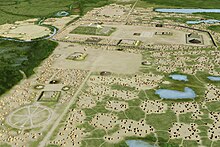Mississippi culture

The Mississippi culture was a Native American culture that appeared from about AD 900 and emerged from the Woodland period . Its center was on the central Mississippi . It extended to the southeast of what is now the United States and thus roughly to the states of Alabama , Arkansas , Georgia , Illinois , Indiana , Louisiana , Kentucky , Michigan , Missouri , Oklahoma , Tennessee , and Texas . Contacts with the population on the upper reaches of the Mississippi in southern Wisconsin from around 1050, through which cultural techniques spread to the north, coincide with the collapse of the Effigy Mounds culture there .
In addition to hunting and fishing, the Indians of the Mississippi culture also farmed. Among other things, corn and beans were grown . Dogs and turkeys were kept on farm animals . Ornate pottery was also made. As the only Indian culture north of Mexico , the Mississippi culture built fortified cities. These were centers of power and hubs of the extensive trade network. In almost every city, mounds or pyramids were built, so-called mounds . Probably the largest urban settlement was Cahokia . With eight detectable mounds, Ocmulgee in central Georgia is the most diverse settlement of the era. Society was complex and organized in a strictly hierarchical manner. At their head was a priest-king. Parallels to the social order of the Aztecs are obvious.
Little is known about the decline of culture in the 15th and 16th centuries. The most likely causes are diseases and the intensive exploitation of nature (especially through deforestation ), of the destruction of their own economic and livelihoods ( hunting of wild led).
The European invasion was probably also responsible for the decline. Several tribes and neighboring tribes of this culture were confronted with the diseases, acts of war and great brutality and unscrupulousness brought in from Europe in the first half of the 16th century. In 1528 the Apalachee and the Choctaw came into enemy contact with the conquistador Pánfilo de Narváez in the area of Mobile Bay . In 1540, Hernando de Soto and his team met the Apalachee and the Choctaw on their expedition and plundering campaign in search of gold, and the battle of Mauvilla broke out . In 1541 they reached the Mississippi, where they stayed for a month until they could cross the river by rafting. While still on the Mississippi, the Spaniards were massively attacked by the Natchez and other tribes that had united against the invaders.
The descendants are the Natchez , Alabama , Apalachee , Caddo , Chickasaw , Choctaw , Creek , Guale , Hitchiti , Houma , Illinois , Kansa , Miami , Missouri , Osage , Quapaw , Seminoles , Shawnee , Timucua , Tunica , Yamasee and Yuchi . The Mississippi culture is the last prehistoric culture in North America before contact with the Europeans.
Individual evidence
- ↑ John R. Swanton : The Indian Tribes of North America (= Smithsonian Institution. Bureau of American Ethnology. Bulletin. 145, ZDB -ID 799398-5 ). United States Government Printing Office, Washington DC 1952, p. 189.
Web links
- National Park Service: The Mississippian and Late Prehistoric Period (AD 900--1700)
- The Mound Builder Cultures: Adena, Hopewell, and Mississippi
- National Park Service: Ancient Architects of the Mississippi
